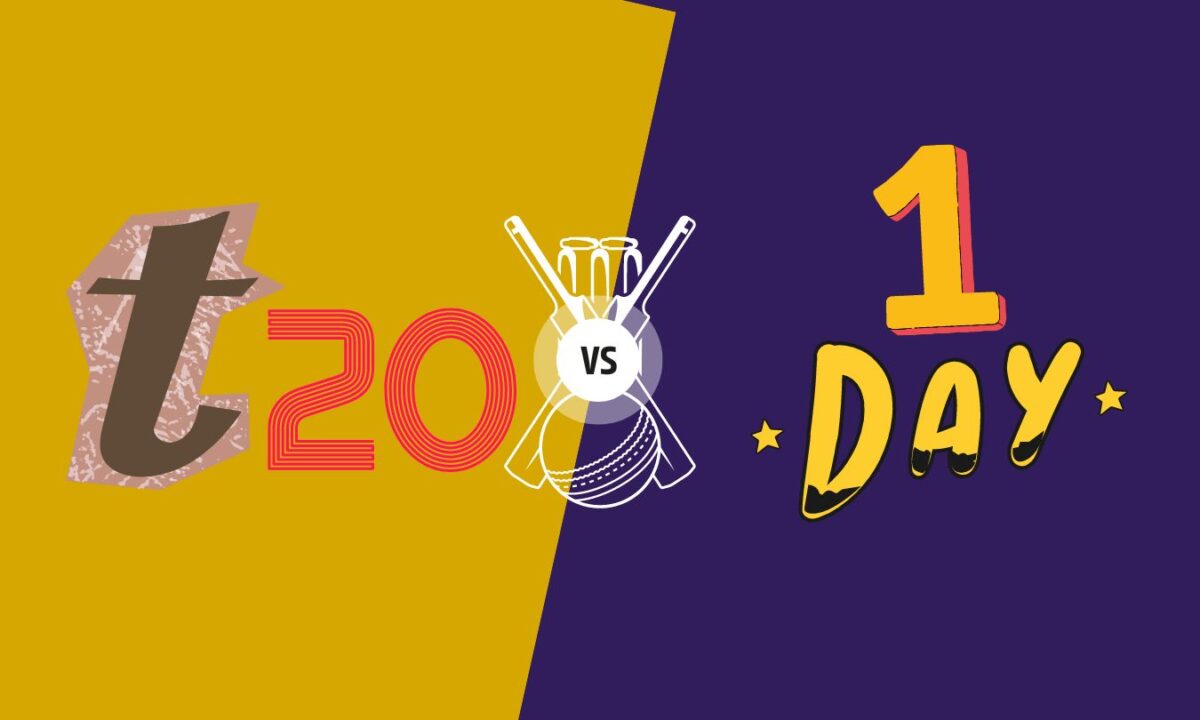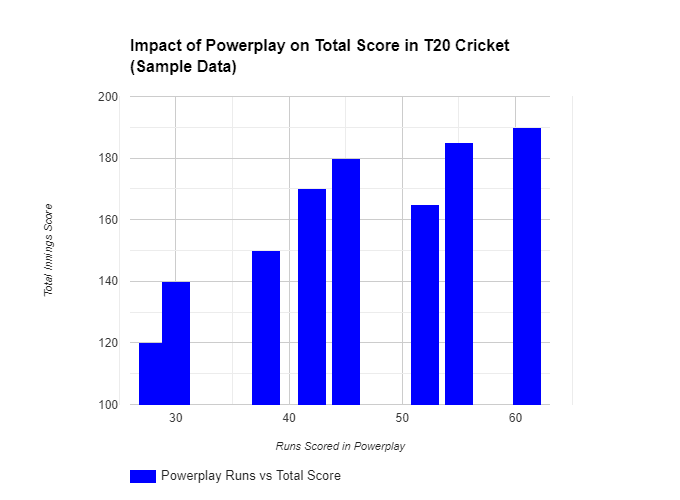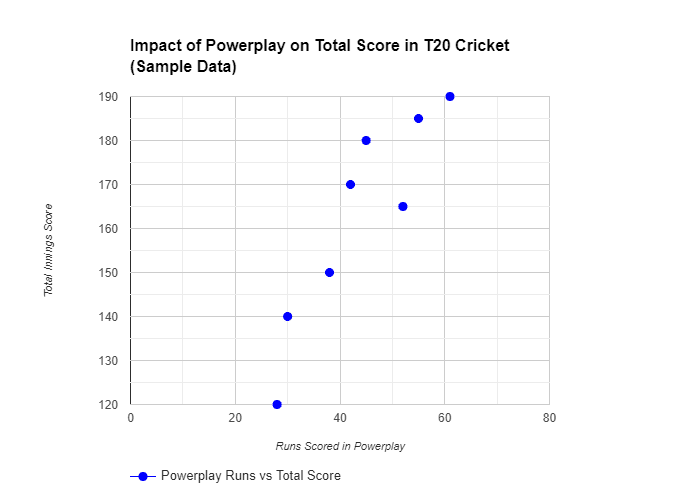The understand of power play in T20 cricket is must for fast-paced world of T20 cricket thrives on explosive batting and strategic bowling. This guide delves into the power play, explaining its definition, purpose, and how it shapes the course of a T20 match.
Importance of Power Play in Cricket
T20 cricket is a condensed format known for its high-scoring matches and intense action. The power play period plays a pivotal role in setting the tone for the entire game.
By understanding this rule, you can gain a deeper appreciation for the strategies employed by both batting and bowling sides.
Powerplay in Cricket Formats
| Feature | T20 Cricket | ODI Cricket |
|---|---|---|
| Purpose | Give the batting team a head start | Give the batting team a head start and control the run rate later |
| Number of Powerplays | One | Multiple (P1, P2, P3) |
| Duration of Powerplay(s) | First 6 overs | Varies by stage (e.g., First 10 overs for P1) |
| Fielding Restrictions | Only 2 fielders outside the 30-yard circle | Varies by stage (e.g., More fielders outside the circle in later powerplays) |
Meaning and Purpose of Power Play in T20 Cricket
A power play is a set of overs at the beginning of a T20 innings where fielding restrictions are imposed. So, how does the power play work in T20? Typically, during the first six overs, only two fielders are allowed outside the 30-yard circle.

This rule aims to create a more balanced and exciting game by giving the batting team a chance to score freely in the initial stages. Traditionally, limited-overs cricket involved teams spreading out the fielders to save runs. The power play disrupts this strategy, forcing the fielding team to adopt a more attacking approach.
The historical context of the power play dates back to the 1980s when fielding restrictions were introduced in ODI cricket. The ICC later renamed it the “power play” in 2005.
ICC Cricket Power Play Rules

1. T20 Cricket Powerplay Rules
The powerplay in T20 cricket is a set of overs at the beginning of an innings where fielding restrictions are imposed to give the batting team a chance to score freely and set the pace for the match. Here’s a breakdown of the key points:
- Duration: The powerplay lasts for the first six overs of the innings.
- Fielding Restrictions: Only two fielders are allowed outside the 30-yard circle around the batsman. This creates larger gaps in the field, making it easier for the batsmen to score boundaries.
- Bowling: Bowlers need to be strategic during the powerplay. Utilizing a variety of deliveries like slower balls, yorkers, and deceptive pace variations can help restrict runs and create wicket-taking opportunities.
- Batting: Batsmen should capitalize on the fielding restrictions by playing a mix of aggressive strokes and smart running between the wickets. Finding the balance between calculated risks and rotating the strike efficiently is crucial.
- Impact: A strong batting performance in the powerplay can set the tone for the entire match by putting pressure on the fielding team. Conversely, taking wickets during the powerplay can put the batting team on the back foot and disrupt their plans.
Here are some additional points to remember:
- The powerplay is mandatory and cannot be changed by the batting team.
- If there are more than two fielders outside the circle during the powerplay, the umpire will signal a no-ball, giving the batting team a free hit.
- The powerplay rule applies to all major T20 cricket tournaments, including the IPL and the T20 World Cup.
2. One Day (ODI) Cricket Power Play Rules
Unlike T20 cricket with its single powerplay, ODIs (One Day Internationals) have a more nuanced approach. The powerplay rules in ODIs are designed to give the batting team an initial advantage while allowing the fielding team to gradually increase control over the run rate as the innings progresses. Here’s a breakdown of the key points:
Mandatory Powerplay (First 10 Overs):
- Duration: The first 10 overs of the innings.
- Fielding Restrictions: Only two fielders are allowed outside the 30-yard circle, similar to T20 powerplay rules. This grants batsmen more scoring opportunities through boundaries.
Optional Powerplays (Overs 11-40):
- Number: Two optional powerplays of five overs each are available to the fielding team.
- Timing: The fielding team can choose to activate these powerplays at any point between overs 11 and 40. This allows them to adapt their strategy based on the match situation.
- Fielding Restrictions: Similar to the mandatory powerplay, only three fielders are allowed outside the 30-yard circle during these optional powerplays. This provides a slight advantage to the batsmen compared to the later stages of the innings.
Unrestricted Fielding (Overs 41-50):
- Duration: The final 10 overs of the innings.
- Fielding Restrictions: All fielding restrictions are lifted. The fielding team can position their players anywhere on the field, allowing for more aggressive tactics to restrict runs and take wickets.
Additional Points to Remember:
- Once a powerplay (mandatory or optional) starts, it must be completed within five overs. It cannot be paused or resumed later.
- If there are more fielders outside the circle than allowed during a powerplay, a no-ball is awarded.
- Captains need to make strategic decisions regarding when to utilize the optional powerplays. Factors like the score, wicket situation, and bowling form can influence this choice.
Types of Power Plays Not Applicable in T20 Cricket
The concept outlined above applies specifically to limited-overs cricket formats like ODIs and T20s. It’s important to note that T20 cricket does not have different types of power plays categorized as batting, bowling, or fielding power plays.
These terms might be used colloquially to describe a team’s approach during the power play. Still, there are no specific rule variations within T20s themselves.
For instance, you might hear commentators refer to a team’s aggressive batting strategy during this period as their “batting powerplay.” Still, it’s not an official rule term.
Strategies and Impact of the Power Play in T20 Cricket
During the power play (also known as the powerplay in IPL T20, the Indian Premier League), only two fielders are allowed outside the 30-yard circle. This restriction creates more significant gaps in the field, allowing batters to target specific areas for boundaries.
Following are the Bar Chart and Scatter Plot of Power Play impact on T20 cricket. You may see that the total run scored are significantly high when power play utilized effectively.
Bar Chart of Impact of power play on total score in T20 Cricket

Scatter Plot Impact of power play on total score in T20 Cricket

Crafting a Winning Power Play Strategy:
- Batsmen: The power play is a batter’s paradise. Batsmen should capitalize on the fielding restrictions by playing a mix of aggressive strokes and intelligent running between the wickets. Finding the balance between calculated risks and rotating the strike efficiently is critical to maximizing the power play.
- Bowlers: The challenge for bowlers during the power play is to contain the flow of runs without giving away too many scoring opportunities. Utilizing a variety of deliveries, including slower balls, yorkers, and deceptive variations in pace, can help restrict scoring and create wicket-taking chances.
The Power Play’s Influence on the Game:
- A strong batting performance in the power play can provide a significant momentum shift. A flurry of boundaries early on can put the fielding team on the back foot and set a challenging total.
- Conversely, taking wickets during the power play puts immense pressure on the opposition. Early breakthroughs can dismantle the batting team’s plans and completely change the course of the match.
FAQs: Powerplay in T20 Cricket
How does the powerplay work in T20?
What is powerplay in IPL T20?
What is 2nd powerplay in cricket?
What is P1 P2 P3 in ODI?
What is a powerplay in the cricket T20 World Cup?
What is a powerplay in cricket T20 rules?
How many powerplay in T20?
T20 Powerplay Quiz: Test Your Cricket Knowledge!
The powerplay is a heart-pounding phase in T20 cricket, a strategic battle between explosive batting and cunning bowling. But how well do you understand this crucial period? Take this quiz and polls to test your T20 knowledge and impress your friends!
Quiz: Powerplay Puzzler
- How many overs is the powerplay in T20 cricket?
- a) 3 overs
- b) 6 overs (Correct Answer)
- c) Entire first innings
- During the powerplay, how many fielders are allowed outside the 30-yard circle?
- a) Unlimited
- b) 4 (Incorrect)
- c) 2 (Correct Answer)
- What is the PRIMARY purpose of the powerplay in T20 cricket?
- a) To save runs for the fielding team (Incorrect)
- b) To give the batting team a scoring advantage (Correct Answer)
- c) To create a break for the bowlers
- A strong batting performance in the powerplay can lead to what for the fielding team?
- a) More bowling options (Incorrect)
- b) Increased pressure to take wickets (Correct Answer)
- c) A chance to relax and regroup
- What type of deliveries are often used by bowlers during the powerplay to restrict scoring?
- a) Long hops (Incorrect)
- b) Slower balls, yorkers, and pace variations (Correct Answer)
Poll: Powerplay Powerhouses
Which batting strategy is MOST effective during the powerplay?
- A) Playing ultra-defensively to avoid losing wickets (Less popular choice)
- B) Mixing aggressive strokes with smart running between the wickets (More popular choice)
Bonus Question:
The concept of a “second powerplay” exists in ODI cricket. True or False?
Answer Key:
- b) 6 overs
- c) 2
- b) To give the batting team a scoring advantage
- b) Increased pressure to take wickets
- b) Slower balls, yorkers, and pace variations
Check Your Score!
Give yourself 1 point for each correct answer.
- 5 points: You’re a T20 powerplay pro!
- 3-4 points: You’ve got a good grasp of the powerplay’s dynamics.
- 1-2 points: Time to brush up on your T20 knowledge!
Conclusion: Mastering the Power Play, Mastering T20 Cricket
The power play is a defining element of T20 cricket, demanding strategic brilliance from both batsmen and bowlers. By mastering this phase, teams can gain a significant advantage and set the stage for victory.
Understanding the power play enhances the viewing experience for fans, allowing them to appreciate the calculated risks and tactical battles that unfold during this crucial period.
This blog post has equipped you with the knowledge to dissect the power play and its influence on the exciting world of T20 cricket. So, the next time you witness a T20 match, keep an eye on the power play – it might just be the turning point of the game!
James Paul is a former first-class cricketer and passionate cricket analyst. His decades of experience on the field and his love for the game shape his insights into the strategies and personalities that define world-class cricket.
